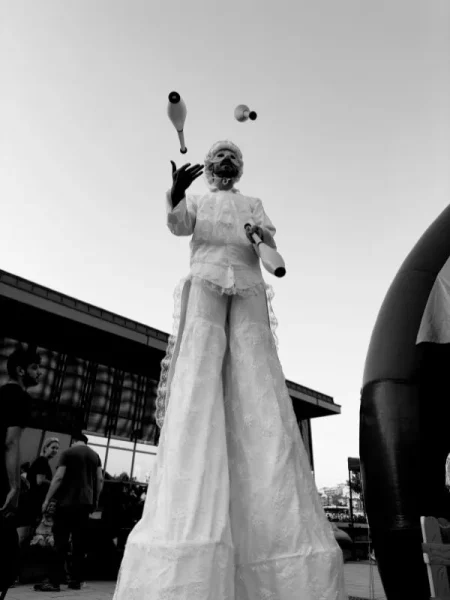Stilts 101
Learn what stilts are, the different types of stilts, how to get started and lots more
What Are Stilts, Technically?
Let’s get basic for a second. Stilts are tools (or toys, or props, depending on who’s using them) that allow you to stand and walk above the ground by adding height to your legs. Some strap onto your feet; others have platforms you stand on and hold with your hands. Some are rigid; some bounce. Some are made for fun, others for function.
But all of them demand one thing: balance.
Wait – People Actually Walk on Those Things?
Yes. And not just circus performers in glittery costumes.
Stilts have been around for centuries – used by shepherds in France, workers in marshes, performers in street parades, drywallers in construction and yes, clowns at kids’ parties. But beyond the novelty and utility, there’s something kind of magical about walking tall. Elevated, sure – but grounded in a whole different way.
And no, you don’t need to be a daredevil or gymnast to learn.
Why Stilts Are Easier (and Harder) Than You Think
Here’s the thing – when most people see stilts, they assume one of two things:
1. “That looks impossible.”
2. “I bet I’d fall and snap my ankle in 0.3 seconds.”
Honestly? It does look sketchy at first. You’re higher up, less stable and a little disconnected from the ground. But the catch is: with the right kind of stilts – and a little patience – your body adapts faster than you’d think.
Balance improves. Core strength kicks in. Your mind stops panicking. And then, all of a sudden, you’re just… walking. But taller.
Different Types of Stilts
This isn’t a one-size-fits-all thing. Different stilts serve different purposes – and some are easier to start with than others.
Performance Stilts
These are the tall, theatrical ones you see in parades, festivals and yes, Cirque du Soleil.
– Peg stilts: Lightweight, fast, and strapped directly to your legs. Great for performers and dancers. Requires skill and coordination.
– Drywall stilts: Adjustable height, stable base, commonly used by painters or construction workers. Surprisingly solid for beginners.
– Hand-held stilts: Think old-school toys. Two cans and some string – or upgraded wooden versions. Fun, but not really for long walks.
Jumping Stilts (aka “Power stilts”)
These are spring-loaded and look part robot, part kangaroo. Designed for running, flipping or bouncing. Not for total beginners, but undeniably fun once you’re comfy on regular stilts.
Practical Stilts
Used in farming, flood zones or even coconut harvesting. Still very much a thing in certain places – especially where elevation helps navigate soggy ground.
So what’s best for a first-timer? Drywall stilts or shorter peg stilts, hands down. They’re stable, affordable and let you focus on the walking before the flair.



How to Get Started Without Faceplanting
Okay, you’ve got a pair of stilts. Now what?
Here’s how to take your first steps – literally and safely:
1. Use a spotter or wall. This is non-negotiable for day one. You need a little backup.
2. Start on soft ground. Grass is ideal. Avoid concrete – your shins will thank you.
3. Adjust for comfort. Make sure straps are tight but not cutting off circulation. Feet flat, knees soft.
4. Get upright, slowly. Use something stable to push up. Don’t leap – this isn’t parkour.
5. Look ahead, not down. Your balance follows your eyes. So pick a spot and walk toward it.
6. Take small steps. This isn’t a race. Think shuffle, not strut.
7. Keep your core engaged. It sounds technical, but it really just means: stay centered.
And yes, falling happens. But when you fall from three feet up, it’s not that different from stumbling off a curb – especially if you’re prepared. Controlled falls are part of learning. Don’t overthink them.
It’s Not Just About the Height (But That Part Is Cool)
Sure, you’re taller. But stilting also shifts how you move. You become aware of your posture, your stride, your breath. Everything gets more deliberate.
And then there’s the quiet confidence. There’s something oddly empowering about rising above your normal eye level and still feeling grounded. It’s not just about standing higher – it’s about trusting your body to carry you there.
Also? Kids stare. Adults smile. Strangers want to talk. Stilting is a conversation starter. You feel slightly ridiculous and deeply awesome at the same time.
What You’re Training (Without Realizing It)
Walking on stilts turns into a low-key full-body workout. Seriously.
Core stability: Keeping upright on two sticks? It demands balance.
Leg endurance: Quads, calves, hamstrings – they’re all in.
Ankle and foot strength: Those tiny stabilizers are suddenly doing overtime.
Posture awareness: You start walking taller – literally and figuratively.
Mental focus: You can’t check your phone or zone out. You’re in it, fully.
It’s like walking meditation – but on stilts.
Mistakes You’ll Definitely Make (And That’s Okay)
Let’s normalize the awkward phase, yeah?
Leaning too far forward: You’ll tip. Quick.
Locking your knees: Bad idea. Stay springy.
Overcorrecting every wobble: You’ll exhaust yourself. Micro-adjust instead.
Skipping warm-up: Your calves will rebel. Trust me.
Getting cocky too fast: Just because you walked 10 feet doesn’t mean you’re ready to spin or moonwalk (yet).
But every wobbly misstep teaches you something. You learn faster by failing – especially when it’s slightly ridiculous and you’re laughing.
Choosing Your First Pair: A Few Quick Tips
You don’t need top-shelf gear to start – but you do want safety and fit.
Drywall stilts (like Pentagon Tools or Dura-Stilts): Great for newbies. Adjustable, sturdy, no extra balance training needed.
Low-rise peg stilts: Easier than high ones. Find a set that straps snugly and doesn’t feel like it’ll twist off.
Avoid cheap novelty stilts: If it looks like a party favor, skip it. Wobbling five feet off the ground is not where you want structural surprises.
Budget: around $100–200 for solid beginner stilts. Totally worth it.
Stilting Around the World
It’s not just a novelty hobby – stilts have deep roots.
In Namur, Belgium, they’ve hosted stilt battles since the 15th century. Two teams face off on stilts and try to knock each other over. It’s like jousting, but wobblier.
In Southern China, stilt dancing blends acrobatics, storytelling and cultural celebration.
In New Orleans or Rio, you’ll find stilt performers parading through festivals, bringing energy, rhythm and height to the crowd.
And in construction zones? Drywallers rely on stilts every day to reach ceilings without ladders.
Every culture that’s tried stilting has given it its own flavor – and honestly, that’s kind of beautiful.
So, Is Stilting a Skill, a Sport or Just a Weird Party Trick?
All of the above.
It can be a form of self-expression, a job, a performance tool or just something cool you do for fun. The versatility is part of the appeal. You can get into stilt dancing, circus work, aerial performance or just enjoy walking taller at the park on a Sunday.
There are no rules, really – just physics. And a little courage.
Where to Learn More (Besides Just Falling Over a Lot)
YouTube: Search for “stilting basics” or “how to walk on stilts.” Tons of creators share tutorials.
Circus schools: Places like Circus Center (SF), NECCA (Vermont), and others often include stilting in beginner courses.
Festivals or street performer workshops: These pop up in local arts or cultural events and usually welcome beginners.
Reddit or niche forums: Try r/juggling or specialty circus threads. The community’s small but super helpful.
Practice, chat, share, repeat.
Final Thoughts: Why Bother Walking on Stilts?
Honestly? Because it’s fun. And weird. And just a little daring.
We don’t get enough of that as adults. We move through the world at eye level, playing it safe. Stilts mess with that. They throw you off balance – on purpose. They demand presence. And they remind you that looking a little ridiculous is sometimes the most liberating thing.
So yeah. Learn to walk tall. Wobble a little. Laugh a lot. And maybe – just maybe – rediscover a part of yourself that still believes in doing strange, slightly magical things just because they’re possible.
Strap in. Stand up. The world looks different from up here.
